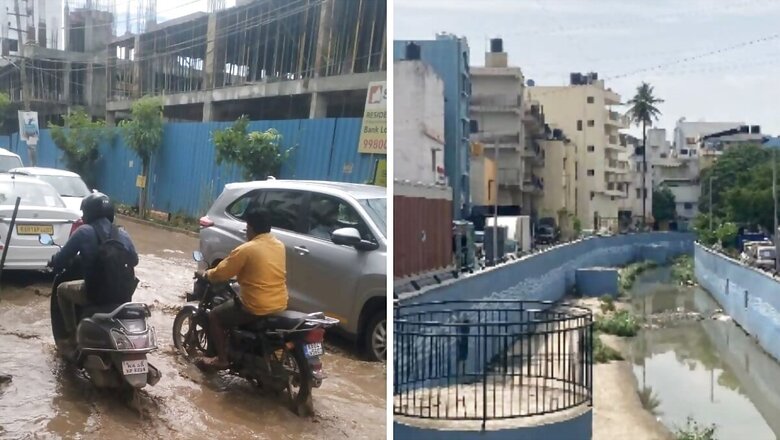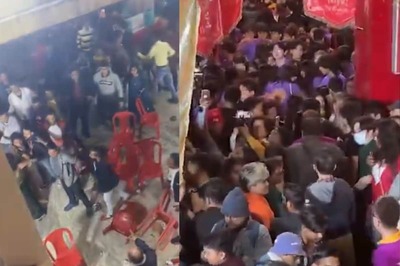
views
Six hours of continuous rain on Monday morning left Bengaluru’s roads waterlogged. While as usual, traffic advisories were issued, residents tweeted warnings about heavily flooded areas, and some offices advised employees to work from home, experts believe the real issue to address is climate change.
Urban and environmental experts say this is yet another example of the severe climate crisis the world is facing, with Bengaluru bearing the brunt. Issues such as massive concretisation, clogged drains, and illegal encroachments over stormwater drains continue to persist, but experts believe the solution lies in good governance, effective implementation of scientifically proven measures, and, most importantly, the will to bring about a change.
“Even God can’t help the world when it comes to climate change, it is only us. We are facing a severe crisis and need to act fast. This isn’t a small issue that can be fixed with a short-term solution,” says civic activist Srinivas Alavilli.
He explained, “The analogy is simple: it’s like treating a serious illness with just a paracetamol when it requires stronger measures and sustained treatment. We are at a breaking point due to heavy concretisation, reckless approval of construction projects, and encroachments over our stormwater drains. We need strong city-level leadership, deep community involvement, and solid urban governance structures.”
Alavilli also pointed out that development is often confused with building roads, flyovers and other large structures, when the real needs are blue green infrastructure such as lakes, stormwater drains and effective waste management system.
He highlighted the example of Bengaluru’s Outer Ring Road, a major IT hub that floods regularly, causing traffic snarls across the city. The main reason, he noted, is the massive concrete structures built without proper consideration of water management.
“There needs to be coordinated action across all agencies. The civic body, Bruhat Bengaluru Mahanagara Palike (BBMP), which operates with very limited resources compared to cities like Mumbai and Hyderabad is struggling to keep up,” Alavilli said.
Yelahanka zonal commissioner Visited houses inundated in Bhuvaneshwari Nagar, which is in downstream of Amruthahalli lake. pic.twitter.com/iOqu2iCukE— Bruhat Bengaluru Mahanagara Palike (@Bbmpcares) August 12, 2024
BJP leader Tejasvi Surya, meanwhile, said on X, “Metro, suburban railway & bus system have to complement one another & the BMLTA was a step in the right direction. The current government has neither taken any step to form the BMLTA nor has it delegated traffic engineers any power to plan the traffic management of the city.”
For long, we have implemented band-aid solutions to Bengaluru's traffic problem and poor urban infra, instead of approaching it from the perspective of a well-structured town planning body. Such solutions only fix the symptom and is not the remedy for the problem itself.The… pic.twitter.com/S10ybCW9tO
— Tejasvi Surya (@Tejasvi_Surya) August 12, 2024
K-100 MODEL: HOW IT CAN BE FOLLOWED
A stark contrast in Bengaluru’s waterlogging situation can be seen between Chikka Lalbagh and Bellandur. The 9.2-km K-100 waterway project has become a success story, demonstrating how effective cleaning and maintenance of our rajakaluves (stormwater drains) can mitigate flooding. The project, which runs from Chikka Lalbagh near Bengaluru’s KR Market to Bellandur Lake, aims to completely clean the bed of the rajakaluve and ensure the flow of clean water. This stormwater drain has become a “model” that the city could emulate.
Nearly completed, it withstood the heavy rain on the night of August 11 and 12, preventing waterlogging in areas such as Shantinagar and Ejipura, while places like the Outer Ring Road, Hebbal, and Yelahanka were flooded.
View this post on Instagram
In 2016, the National Green Tribunal (NGT) made an important decision by canceling the environmental clearance for a Rs 2,300-crore project on the Bellandur Lake wetland. The court not only stopped the construction, but also ordered the reclamation of 3.10 acres of lake land and the restoration of several stormwater drains. Following the NGT’s directive to remove concrete along the drain’s entire length, civic authorities began exploring ways to improve the area. Consequently, the BBMP launched a project to revitalise the K-100 drain, collaborating with urban designers and architects from the Bengaluru-based Mod Foundation.
The “model” K-100 drain passes through areas like KR Market, Shanti Nagar, Hosur Road, Ejipura, National Games Village, Koramangala, and ST Bed Layout before ending at Bellandur. This project is now seen as an example that could be expanded to help protect Bengaluru from flooding. As the drain flows through various types of land and conditions, it offers ideas on how to adapt it to different parts of the rapidly growing city. The K-100’s watershed covers 32 square kilometres and carries one-twelfth of the city’s sewage and runoff.
Progress of the K100 Citizens Waterway Project from 2020 to now! A dramatic improvement in the quality of water and the nature of public space in and around the K-100 Raja Kaluve.https://t.co/Ts1iNVUu5K— Mod Foundation (@mod_foundation) September 25, 2023
CITY’s SEWAGE SYSTEM IS BROKEN, SAYS K-100 PLANNER
Urban planner and architect Naresh Narasimhan from the Mod Foundation, who conceptualized this BBMP project, told News18 that the water now flows smoothly through the old city, with clean waterways, no silt and very little solid waste. With the drain walls lowered, people are becoming more disciplined and keeping an eye on others to prevent garbage dumping in the stormwater drains, which could lead to clogging.
“All the stormwater drains in Bengaluru have solid silt that has hardened over time. The capacity of the stormwater drains is more than enough. Bengaluru should not flood at all. It is flooding because of these reasons: one is that 30 per cent of the drains are filled with solid waste, 30 percent illegal sewage,30% is solidified silt, which leaves only 10% capacity for storm water. So, when it rains heavily the water mixes with the sewage and solid waste and overflows causing flooding. People think of them as garbage pits. The people are also to blame, not just the government. Once I found an entire sofa set inside the drain, along with the side tables. The sewage system in the city is broken,” he added, noting that only ten per cent of the drains are functioning properly.
Cleared waterlogged at 1st and 2nd Block Jayanagar roads by bbmp south zone disaster management team.#BBMP #BBMPCares #BengaluruRains #BengaluruRain @DKShivakumar @BBMPAdmn @BBMPCOMM pic.twitter.com/oiTKV6hTfN— Bruhat Bengaluru Mahanagara Palike (@Bbmpcares) August 12, 2024
“The rain last night showed that in the areas that we have worked on, water is flowing smoothly, and places are not flooded, but the areas where the drains are blocked are flooded. What does that say,” asks Narasimhan.
He also pointed out that the 10 kilometres of drain they worked on cost only Rs 175 crore. “See the effect. The sewage is gone, the sewage treatment plant in Challaghatta is working, and the lakes in the Kolar district are full of secondary treated water. This has multiple advantages. The problem is that most politicians think of city development only as building roads, underpasses, tunnels and flyovers. Why don’t they complement it with a good stormwater drain system, walkable barrier-free footpaths and garbage disposal system,” Naresh asks.

















Comments
0 comment